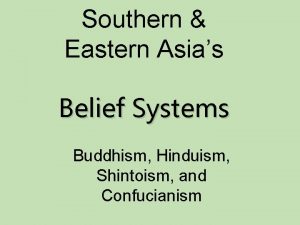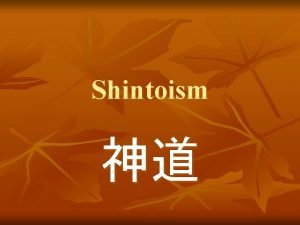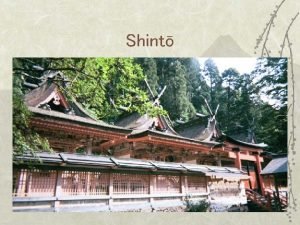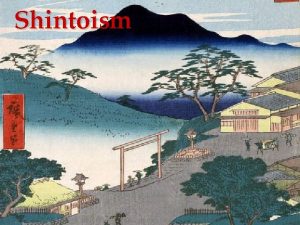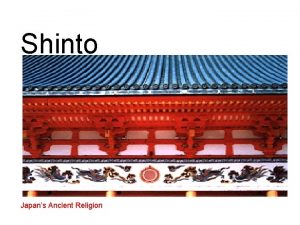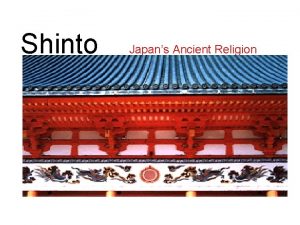Shintoism n Shint is a native religion of














- Slides: 14

Shintoism 神道

n Shintō is a native religion of Japan. It involves the worship of kami, which could be translated to mean gods, nature spirits, or just spiritual presences.

n Worship of kami, also mean "sacred spirits which take the form of things and concepts important to life, such as wind, rain, mountains, trees, rivers and fertility.

Izanagi no Mikomoto ("Exalted Male") Izanami no Mikoto ("Exalted Female")


Amaterasu-ōmikami

Beliefs n n n Believers revere "musuhi", the Kamis' creative and harmonizing powers. They aspire to have "makoto", sincerity or true heart. This is regarded as the way or will of Kami. Shinto holds a generally positive view of human nature. All of humanity is regarded as "Kami's child. " Thus all human life and human nature is sacred. Morality is based upon that which is of benefit to the group. "Shinto emphasizes right practice, sensibility, and attitude. "

Beliefs n In its view of history, Shinto adheres to the cyclical approach, according to which there is a constant recurrence of historical patterns. Shinto does not have the concept of the "last day": there is no end of the world or of history. the present moment is the very center in the middle of all conceivable times. In order to participate directly in the eternal development of the world, it is required of Shintoists to live fully each moment of life, making it as worthy as possible.

Beliefs n n parishioners of a shrine believe in their tutelary kami as the source of human life and existence. Each kami has a divine personality and responds to truthful prayers. Shinto does not believe in any propaganda or preaching, thus producing no real icon or symbol for the religion as it is mostly based off of traditions. Unlike western religions there is no real dogma , and instead the main focus becomes the worship of the Kami, the divine consciousness that runs through everything.

The Four Affirmations of Shintoism 1. Tradition and the Family. 2. Love of Nature 3. Physical Cleanliness 4. Matsuri

Practices n Shinto ceremonies are designed to appeal to the kami for benevolent treatment and protection and consist of: n n abstinence (imi) offerings prayers and purification (harae) by washing with water, symbolically removes the dust and impurities that cover one's inner mind.

Practices n Shinto does not have weekly religious services. Some may go to the shrines on the 1 st and 15 th of each month and on the occasions of rites or festivals (matsuri), which take place at fixed times during the year n n n including a baby’s first visit to its tutelary kami soon after birth, the Shichi-go-san (Seven-Five-Three) festival on Nov 15 th where three and seven year old girls and five year old boys go to pray for good health, and the traditional wedding ceremony.


Thank You


